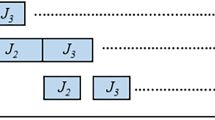Abstract
The Resource Constrained Project Scheduling Problem is one of the most intensively investigated scheduling problems. It requires scheduling a set of interrelated activities, while considering precedence relationships, and limited renewable resources allocation. The objective is to minimize the project duration. We propose a new destructive lower bound for this challenging \({\mathcal {NP}}\)-hard problem. Starting from a previously suggested LP model, we propose several original valid inequalities that aim at tightening the model representation. These new inequalities are based on precedence constraints, incompatible activity subsets, and nonpreemption constraints. We present the results of an extensive computational study that was carried out on 2,040 benchmark instances of PSPLIB, with up to 120 activities, and that provide strong evidence that the new proposed lower bound exhibits an excellent performance. In particular, we report the improvement of the best known lower bounds of 5 instances.


Similar content being viewed by others
References
Alvarez-Valdés, R., & Tamarit, M. (1993). The project scheduling polyhedron: Dimension, facets and lifting theorems. European Journal of Operational Research, 67, 204–220.
Artigues, C., Demassey, S., & Néron, E. (2008). Resource-constrained project scheduling : Models, algorithms, extensions and applications. New York: Wiley.
Baptiste, P., & Demassey, S. (2004). Tight LP bounds for resource constrained project scheduling. OR Spectrum, 26, 251–262.
Baptiste, P., Le Pape, C., & Nuijten, W. (1999). Satisfiability tests and time-bound adjustments for cumulative scheduling problems. Annals of Operations Research, 92, 305–333.
Brucker, P., & Knust, S. (2000). A linear programming and constraint propagation-based lower bound for the RCPSP. European Journal of Operational Research, 127, 355–362.
Carlier, J., Clautiaux, F., & Moukrim, A. (2007). New reduction procedures and lower bounds for the two-dimensional bin packing problem with fixed orientation. Computers & Operations Research, 34, 2223–2250.
Carlier, J., & Latapie, B. (1991). Une méthode arborescente pour résoudre les problèmes cumulatifs. RAIRO-RO, 25, 311–340.
Carlier, J., & Néron, E. (2000). A new LP-based lower bound for the cumulative scheduling problem. European Journal of Operational Research, 127, 363–382.
Carlier, J., & Néron, E. (2003). On linear lower bounds for the resource constrained project scheduling problem. European Journal of Operational Research, 149, 314–324.
Christofides, N., Alvarez-Valdes, R., & Tamarit, J. (1987). Project scheduling with resource constraints: A branch and bound approach. European Journal of Operational Research, 29, 262–273.
Demeulemeester, E., & Herroelen, W. (2002). Project scheduling: a research handbook (Vol. 49). Boston: Kluwer Academic Publishers.
Erschler, J., Lopez, P., & Thuriot, C. (1991). Raisonnement temporel sous contraintes de ressources et problèmes d’ordonnancement. Revue d’Intelligence Artificielle, 5, 7–32.
Fekete, S., & Schepers, J. (1998). New classes of lower bounds for bin-packing problems. Lecture Notes in Computer Science, 1412, 257–270.
Haouari, M., Kooli, A., & Néron, E. (2012). Enhanced energetic reasoning-based lower bounds for the resource constrained project scheduling problem. Computers & Operations Research, 39, 1187–1194.
Klein, R., & Scholl, A. (1999). Computing lower bounds by destructive improvement: An application to resource-constrained project scheduling. European Journal of Operational Research, 112, 322–346.
Kolisch, R., Sprecher, A., & Drexl, A. (1997). PSPLIB—a project scheduling library. European Journal of Operational Research, 96, 205–216.
Koné, O., Artigues, C., Lopez, P., & Mongeau, M. (2011). Event-based milp models for resource-constrained project scheduling problems. Computers & Operations Research, 38, 3–13.
Lahrichi, A. (1982). Ordonnancements: La notion de parties obligatoires et son application aux problèmes cumulatifs. RAIRO-RO, 16, 241–262.
Mingozzi, A., Maniezzo, V., Ricciardelli, S., & Bianco, L. (1998). An exact algorithm for project scheduling with resource constraints based on a new mathematical formulation. Management Science, 44, 714–729.
Möhring, R., Schulz, A., Stork, F., & Uetz, M. (2003). Solving project scheduling problems by minimum cut computations. Management Science, 49, 330–350.
Nabeshima, I. (1973). Algorithms and reliable heuristics programs for multiproject scheduling with resource constraints and related parallel scheduling. Tokyo: University of Electro-Communications.
Östergård, P. (2001). A new algorithm for the maximum-weight clique problem. Nordic Journal of Computing, 8, 424–436.
Östergård, P. (2002). A fast algorithm for the maximum clique problem. Discrete Applied Mathematics, 120, 197–207.
Pritsker, A., Watters, L., & Wolfe, P. (1969). Multi-project scheduling with limited resources: A zero-one programming approach. Management Science, 16, 93–108.
Schutt, A., Feydy, T., Stuckey, P., & Wallace, M. (2011). Explaining the cumulative propagator. Constraints, 16, 250–282.
van den Akker, J., Diepen, G., Hoogeveen, J. (2007). A column generation based destructive lower bound for resource constrained project scheduling problems. In Proceedings of CPAIOR (pp. 376–390).
Vilim, P. (2011). Timetable edge finding filtering algorithm for discrete cumulative resources. Integration of AI and OR techniques in constraint programming for combinatorial optimization problems. Lecture Notes in Computer Science, 6697, 230–245.
Author information
Authors and Affiliations
Corresponding author
Appendix: New lower bounds
Appendix: New lower bounds
Table 9 lists all the improved lower bounds for the KSD instances of the PSPLIB benchmark.
Rights and permissions
About this article
Cite this article
Haouari, M., Kooli, A., Néron, E. et al. A preemptive bound for the Resource Constrained Project Scheduling Problem. J Sched 17, 237–248 (2014). https://doi.org/10.1007/s10951-013-0354-9
Received:
Accepted:
Published:
Issue Date:
DOI: https://doi.org/10.1007/s10951-013-0354-9




